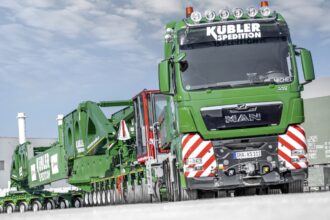Four Liebherr Cranes Build Trimodal Transshipment Terminal
RHENUS PORT LOGISTICS IS INVESTING IN A NEW TRANSHIPMENT TERMINAL IN THE RHINE PORT OF BASEL-KLEINHUNIGEN (SWITZERLAND). EMIL EGGER AG WAS TASKED WITH THE LOGISTICS FOR THE PREFABRICATED CONCRETE ELEMENTS. FOUR LIEBHERR CRANES WERE DEPLOYED IN BASEL TO MAXIMISE EFFICIENCY DURING ALL CONSTRUCTION PHASES.
Spanning a total area of 7,300 square metres, comprising five hall sections and equipped with state-of-the-art technology, the new Terminal 4 is being built in the Rhine port of Kleinhünigen. This trimodal terminal will include five bridge cranes capable of lifting up to 32 tonnes, along with excavators, forklifts, a rail intake hopper for bulk goods, as well as modern rail and truck scales for goods handling and transportation by road, rail and water. Large, prefabricated concrete supports are key elements in port logistics due to the large overhang of the crane girders used to load and unload ships.
Emil Egger AG was commissioned with the logistics for these prefabricated concrete elements. The company deployed two mobile cranes, an LTM 1350-6.1 and an LTM 1650-8.1, along with two crawler cranes, an LR 1250 and an LR 11000, to expertly handle the challenges on site. As access to the construction area is restricted on all sides – both by neighbouring buildings and Südquaistrasse, which could not be closed off, as well as by the Rhine – it was necessary to establish a functioning logistics operation within a very confined space. The installation areas themselves were no less challenging – they were located within the nascent building. All this being done while the concrete work continued in parallel.
During the construction process, the LR 1250 stripped the formwork from the 64-tonne diagonal supports fabricated on-site and transported them to the construction site. The crane subsequently loaded the supports onto low-loaders for internal site transport.
In autumn, the LR 11000, the largest crawler crane in Switzerland, installed the crane track supports and external bone girders, moving two supports weighing 211 tonnes each over a 59-metre radius. Four additional supports, each weighing 265 tonnes, were moved over 45 metres. The crane was configured with a 72-metre-long boom and V-frame. “We first used the V-frame five years ago and our entire team can no longer imagine operating this powerful crane without it,” says Michael Egger from Emil Egger. Despite the fact that the prefabricated support elements, façade scaffolding and the harbour road next to the building significantly limited the crawler crane’s slewing range, sophisticated processes made ballast management possible without an auxiliary crane.
“The VarioTray also proved invaluable: with a small pallet and 180 tonnes of suspended ballast, supports were lifted, moved with the crane and shifted over the water with over 400 tonnes of suspended ballast – a highlight of the construction phase!” reports project manager Andreas Schönenberger.
The 1,000-tonne crawler crane’s other tasks included extending the wall panels, made from cast-in-place concrete, up to the final height of the hall. This was followed by the installation of 14 bone girders connecting the wall panels. Each lift involved a 140-tonne load at a radius of 44 metres and required meticulously planned assembly and dismantling processes due to the limited space.
The tasks assigned to the LTM 1350-6.1 included lifting the diagonal supports, from which the formwork had been stripped by the LR 1250, off the lorry and tilting them to the correct angle so that they could then be lifted into place. These supports cantilever freely over the water and will later support the crane girders.
Towards the end of the operation, the LTM 1650-8.1 took over, closing the gaps in the cast-in-place concrete wall panels and installing the last six bone girders. The new mobile crane lifted the beams, which weigh around 90 tonnes and are 32 metres long, at a radius of around 14 metres. To do this, the 650-tonne machine was required to drive within the construction site after installing each pair of beams.







